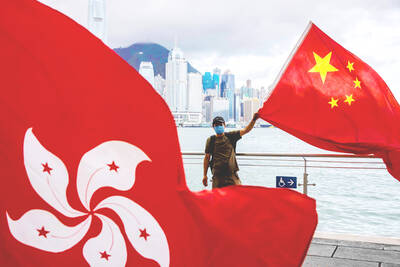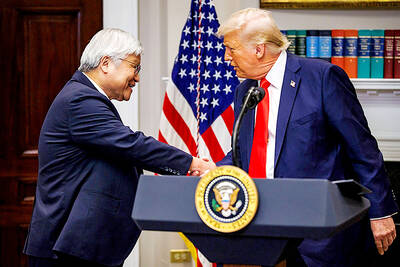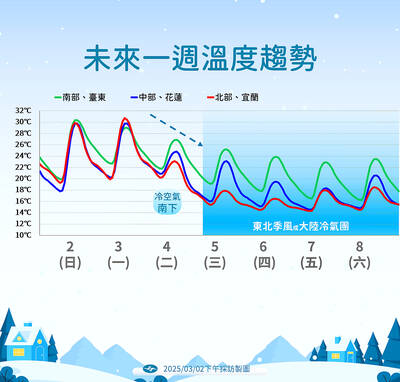Taiwan is to play a critical role in NASA’s Resource Prospector mission, which aims to be the first mining expedition on the moon in the early 2020s, and is expected to use a Taiwanese-made lunar lander to excavate water, oxygen and hydrogen.
The Chungshan Institute of Science and Technology is to build an uncrewed lunar lander to carry a rover to polar regions of the moon to mine resources, particularly subsurface water, international program director Han Kuo-chang (韓國璋) said.
The project is the first time Taiwan has participated in a NASA moon mission and it is hoped it will boost the nation’s visibility in the international aerospace industry.
“Taiwan has an outstanding ability to build electronic components and auxiliary systems for spacecraft, but the nation has had little opportunity to participate in space missions, so it has limited space flight history. The participation in NASA’s Resource Prospector mission might earn Taiwan a ticket into the aerospace industry supply chain,” Han said.
The institute is to deliver a lunar lander on a budget of about NT$1.5 billion (US$46.84 million).
It has to select and test commercially available parts that can function in space, where they would be exposed to extreme heat and radiation, Han said.
“It will be Taiwan’s first moon landing mission, and challenges involved in building a lunar lander include analyzing the orbit, controlling lander posture and velocity and landing the vehicle in the desired location where there is no air resistance and little atmospheric pressure. All those are very difficult,” he said.
However, the Resource Prospector mission is not the first time that the institute has worked on a NASA project.
It built the 1 tonne Alpha Magnetic Spectrometer for the International Space Station, which measures antimatter in cosmic rays and searches for evidence of dark matter.
The spectrometer has functioned uninterruptedly since 2011 in an environment where equipment can easily malfunction due to high daily temperature differentials and high-energy cosmic rays.
“The institute’s space computer is one of the most reliable NASA has ever had, which is why NASA chose to collaborate with Taiwan instead of South Korea in the moon-mining mission,” Han said.
The mission is aimed at reducing the cost of deep-space exploration by harvesting the basic building blocks of life and fuel, and generating the components in space.
NASA began exploring whether there was water on the moon in the 1990s and space missions have since proven its existence.
The Resource Prospector mission is to determine if the water can be extracted, Han said.
The rover is to explore polar regions of the moon and areas where sunlight does not reach, because it is believed that is where sub-surface water is most likely to be found.
The moon lander is expected to be completed by 2018 and the mission is expected to be launched in the early 2020s — if it is given the green light.

SECURITY: The purpose for giving Hong Kong and Macau residents more lenient paths to permanent residency no longer applies due to China’s policies, a source said The government is considering removing an optional path to citizenship for residents from Hong Kong and Macau, and lengthening the terms for permanent residence eligibility, a source said yesterday. In a bid to prevent the Chinese Communist Party (CCP) from infiltrating Taiwan through immigration from Hong Kong and Macau, the government could amend immigration laws for residents of the territories who currently receive preferential treatment, an official familiar with the matter speaking on condition of anonymity said. The move was part of “national security-related legislative reform,” they added. Under the amendments, arrivals from the Chinese territories would have to reside in Taiwan for

CRITICAL MOVE: TSMC’s plan to invest another US$100 billion in US chipmaking would boost Taiwan’s competitive edge in the global market, the premier said The government would ensure that the most advanced chipmaking technology stays in Taiwan while assisting Taiwan Semiconductor Manufacturing Co (TSMC, 台積電) in investing overseas, the Presidential Office said yesterday. The statement follows a joint announcement by the world’s largest contract chipmaker and US President Donald Trump on Monday that TSMC would invest an additional US$100 billion over the next four years to expand its semiconductor manufacturing operations in the US, which would include construction of three new chip fabrication plants, two advanced packaging facilities, and a research and development center. The government knew about the deal in advance and would assist, Presidential

‘DANGEROUS GAME’: Legislative Yuan budget cuts have already become a point of discussion for Democrats and Republicans in Washington, Elbridge Colby said Taiwan’s fall to China “would be a disaster for American interests” and Taipei must raise defense spending to deter Beijing, US President Donald Trump’s pick to lead Pentagon policy, Elbridge Colby, said on Tuesday during his US Senate confirmation hearing. The nominee for US undersecretary of defense for policy told the Armed Services Committee that Washington needs to motivate Taiwan to avoid a conflict with China and that he is “profoundly disturbed” about its perceived reluctance to raise defense spending closer to 10 percent of GDP. Colby, a China hawk who also served in the Pentagon in Trump’s first team,

The arrival of a cold front tomorrow could plunge temperatures into the mid-teens, the Central Weather Administration (CWA) said. Temperatures yesterday rose to 28°C to 30°C in northern and eastern Taiwan, and 32°C to 33°C in central and southern Taiwan, CWA data showed. Similar but mostly cloudy weather is expected today, the CWA said. However, the arrival of a cold air mass tomorrow would cause a rapid drop in temperatures to 15°C cooler than the previous day’s highs. The cold front, which is expected to last through the weekend, would bring steady rainfall tomorrow, along with multiple waves of showers